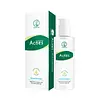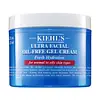What's inside
What's inside
 Key Ingredients
Key Ingredients

 Benefits
Benefits

 Concerns
Concerns

 Ingredients Side-by-side
Ingredients Side-by-side

Water
Skin ConditioningPropylene Glycol
HumectantGlycerin
HumectantPEG-400
Emulsion StabilisingPPG-10 Methyl Glucose Ether
Skin ConditioningPEG-40 Hydrogenated Castor Oil
EmulsifyingPhenoxyethanol
PreservativeCarbomer
Emulsion StabilisingDipropylene Glycol
HumectantButylene Glycol
HumectantTriethanolamine
BufferingPPG-26-Buteth-26
Skin ConditioningChlorphenesin
AntimicrobialCentella Asiatica Extract
CleansingFomes Officinalis Extract
Skin ProtectingO-Cymen-5-Ol
AntimicrobialHamamelis Virginiana Extract
AntiseborrhoeicLaminaria Japonica Extract
Skin ProtectingParfum
MaskingFucose
Skin ConditioningBisabolol
MaskingPropanediol
Solvent1,2-Hexanediol
Skin ConditioningSalix Alba Bark Extract
AstringentViola Yedoensis Extract
Skin ConditioningTaraxacum Officinale Rhizome/Root Extract
Skin ConditioningSodium Hyaluronate
HumectantSalicylic Acid
MaskingPaeonia Lactiflora Root Extract
Skin ConditioningHydrolyzed Sodium Hyaluronate
Skin ConditioningChamomilla Recutita Flower Extract
MaskingButyl Avocadate
Skin ConditioningEthylhexylglycerin
Skin ConditioningCaprylyl Glycol
EmollientMalva Sylvestris Flower Extract
Skin ConditioningLonicera Japonica Flower Extract
Skin ConditioningSebacic Acid
Buffering10-Hydroxydecanoic Acid
Skin ConditioningQuaternium-73
Phospholipids
Skin ConditioningCopper Tripeptide-1
Skin Conditioning1,10-Decanediol
SolventZingiber Officinale Root Extract
MaskingIlex Paraguariensis Leaf Extract
PerfumingCinnamomum Zeylanicum Bark Extract
AntimicrobialCarnosine
Skin ConditioningCaffeine
Skin ConditioningAloe Barbadensis Leaf Juice
Skin ConditioningSodium Ascorbyl Phosphate
AntioxidantTocopherol
AntioxidantAsiaticoside
AntioxidantMadecassic Acid
Skin ConditioningAsiatic Acid
Skin ConditioningTocopheryl Acetate
AntioxidantAlcohol
AntimicrobialWater, Propylene Glycol, Glycerin, PEG-400, PPG-10 Methyl Glucose Ether, PEG-40 Hydrogenated Castor Oil, Phenoxyethanol, Carbomer, Dipropylene Glycol, Butylene Glycol, Triethanolamine, PPG-26-Buteth-26, Chlorphenesin, Centella Asiatica Extract, Fomes Officinalis Extract, O-Cymen-5-Ol, Hamamelis Virginiana Extract, Laminaria Japonica Extract, Parfum, Fucose, Bisabolol, Propanediol, 1,2-Hexanediol, Salix Alba Bark Extract, Viola Yedoensis Extract, Taraxacum Officinale Rhizome/Root Extract, Sodium Hyaluronate, Salicylic Acid, Paeonia Lactiflora Root Extract, Hydrolyzed Sodium Hyaluronate, Chamomilla Recutita Flower Extract, Butyl Avocadate, Ethylhexylglycerin, Caprylyl Glycol, Malva Sylvestris Flower Extract, Lonicera Japonica Flower Extract, Sebacic Acid, 10-Hydroxydecanoic Acid, Quaternium-73, Phospholipids, Copper Tripeptide-1, 1,10-Decanediol, Zingiber Officinale Root Extract, Ilex Paraguariensis Leaf Extract, Cinnamomum Zeylanicum Bark Extract, Carnosine, Caffeine, Aloe Barbadensis Leaf Juice, Sodium Ascorbyl Phosphate, Tocopherol, Asiaticoside, Madecassic Acid, Asiatic Acid, Tocopheryl Acetate, Alcohol
Water
Skin ConditioningGlycerin
HumectantPropanediol
SolventDimethicone
EmollientIsononyl Isononanoate
EmollientHydroxyethylpiperazine Ethane Sulfonic Acid
BufferingPhenoxyethanol
PreservativeCarbomer
Emulsion StabilisingButylene Glycol
HumectantChlorphenesin
AntimicrobialCaprylyl Glycol
EmollientDimethiconol
EmollientSodium Hydroxide
BufferingXanthan Gum
EmulsifyingPentylene Glycol
Skin ConditioningTetrasodium EDTA
Tocopheryl Acetate
AntioxidantMenthoxypropanediol
MaskingPseudoalteromonas Ferment Extract
HumectantBiosaccharide Gum-1
HumectantSarcosine
Skin ConditioningSalicylic Acid
MaskingWater, Glycerin, Propanediol, Dimethicone, Isononyl Isononanoate, Hydroxyethylpiperazine Ethane Sulfonic Acid, Phenoxyethanol, Carbomer, Butylene Glycol, Chlorphenesin, Caprylyl Glycol, Dimethiconol, Sodium Hydroxide, Xanthan Gum, Pentylene Glycol, Tetrasodium EDTA, Tocopheryl Acetate, Menthoxypropanediol, Pseudoalteromonas Ferment Extract, Biosaccharide Gum-1, Sarcosine, Salicylic Acid
 Reviews
Reviews

Ingredients Explained
These ingredients are found in both products.
Ingredients higher up in an ingredient list are typically present in a larger amount.
Butylene Glycol (or BG) is used within cosmetic products for a few different reasons:
Overall, Butylene Glycol is a safe and well-rounded ingredient that works well with other ingredients.
Though this ingredient works well with most skin types, some people with sensitive skin may experience a reaction such as allergic rashes, closed comedones, or itchiness.
Learn more about Butylene GlycolCaprylyl Glycol is a humectant and emollient, meaning it attracts and preserves moisture.
It is a common ingredient in many products, especially those designed to hydrate skin. The primary benefits are retaining moisture, skin softening, and promoting a healthy skin barrier.
Though Caprylyl Glycol is an alcohol derived from fatty acids, it is not the kind that can dry out skin.
This ingredient is also used as a preservative to extend the life of products. It has slight antimicrobial properties.
Learn more about Caprylyl GlycolCarbomer is a polymer of acrylic acid. Its main role is to create a gel consistency.
A high amount of carbomer can cause pilling or balling up of products. Don't worry, most products contain 1% or less of carbomer.
Chlorphenesin is a synthetic preservative. It helps protect a product against bacteria in order to extend shelf life. In most cases, Chlorphenesin is paired with other preservatives such as phenoxyethanol and caprylyl glycol.
Chlorphenesin is a biocide. This means it is able to help fight the microorganisms on our skin. It is also able to fight odor-releasing bacteria.
Chlorphenesin is soluble in both water and glycerin.
Studies show Chlorphenesin is easily absorbed by our skin. You should speak with a skincare professional if you have concerns about using Chlorphenesin.
Learn more about ChlorphenesinGlycerin is already naturally found in your skin. It helps moisturize and protect your skin.
A study from 2016 found glycerin to be more effective as a humectant than AHAs and hyaluronic acid.
As a humectant, it helps the skin stay hydrated by pulling moisture to your skin. The low molecular weight of glycerin allows it to pull moisture into the deeper layers of your skin.
Hydrated skin improves your skin barrier; Your skin barrier helps protect against irritants and bacteria.
Glycerin has also been found to have antimicrobial and antiviral properties. Due to these properties, glycerin is often used in wound and burn treatments.
In cosmetics, glycerin is usually derived from plants such as soybean or palm. However, it can also be sourced from animals, such as tallow or animal fat.
This ingredient is organic, colorless, odorless, and non-toxic.
Glycerin is the name for this ingredient in American English. British English uses Glycerol/Glycerine.
Learn more about GlycerinPhenoxyethanol is a preservative that has germicide, antimicrobial, and aromatic properties. Studies show that phenoxyethanol can prevent microbial growth. By itself, it has a scent that is similar to that of a rose.
It's often used in formulations along with Caprylyl Glycol to preserve the shelf life of products.
Propanediol is an all-star ingredient. It softens, hydrates, and smooths the skin.
It’s often used to:
Propanediol is not likely to cause sensitivity and considered safe to use. It is derived from corn or petroleum with a clear color and no scent.
Learn more about PropanediolSalicylic Acid (also known as beta hydroxy acid or BHA) is a well-known ingredient for treating skin that struggles with acne and clogged pores. It exfoliates both the skin's surface and deep within the pores to help clear out buildup, control oil, and reduce inflammation.
Unlike AHAs (alpha hydroxy acids), salicylic acid is oil-soluble. This allows it to penetrate into pores which makes it especially effective for treating blackheads and preventing future breakouts.
Salicylic acid is also known for its soothing properties. It has a similar structure to aspirin and can calm inflamed or irritated skin, making it a good option for acne-prone skin that is also sensitive.
Concentrations of 0.5-2% are recognized by the U.S. FDA as an over-the-counter topical acne product.
It can cause irritation and/or dryness if one's skin already has a compromised moisture barrier, so it's best to focus on repairing that before introducing this ingredient into your routine.
While salicylic acid does not increase sun sensitivity, it’s still important to wear sunscreen daily to protect your skin.
If you are looking for the ingredient called BHA or Butylated Hydroxyanisole, click here.
Learn more about Salicylic AcidTocopheryl Acetate is AKA Vitamin E. It is an antioxidant and protects your skin from free radicals. Free radicals damage the skin by breaking down collagen.
One study found using Tocopheryl Acetate with Vitamin C decreased the number of sunburned cells.
Tocopheryl Acetate is commonly found in both skincare and dietary supplements.
Learn more about Tocopheryl AcetateWater. It's the most common cosmetic ingredient of all. You'll usually see it at the top of ingredient lists, meaning that it makes up the largest part of the product.
So why is it so popular? Water most often acts as a solvent - this means that it helps dissolve other ingredients into the formulation.
You'll also recognize water as that liquid we all need to stay alive. If you see this, drink a glass of water. Stay hydrated!
Learn more about Water